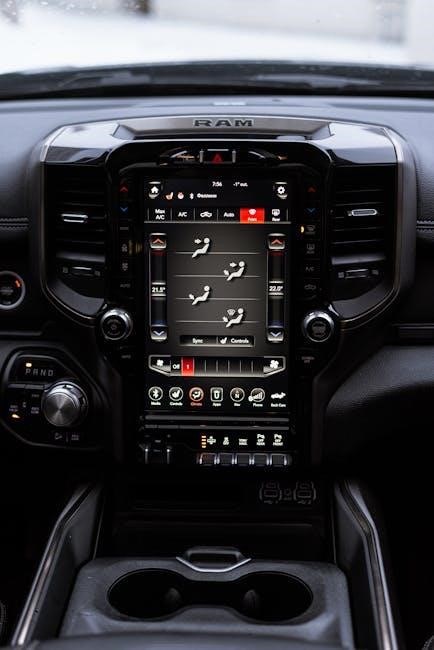Welcome to the 2016 Ram 1500 Owner’s Manual. This guide provides essential information for safe‚ efficient‚ and enjoyable vehicle operation. Read it carefully to understand features‚ maintenance‚ and troubleshooting tips for optimal performance and longevity.
Overview of the Manual’s Purpose and Structure
The 2016 Ram 1500 Owner’s Manual is designed to provide owners with comprehensive information for optimal vehicle operation. It covers essential features‚ maintenance routines‚ and troubleshooting guidelines to ensure safety and efficiency. Structured logically‚ the manual includes sections on instrument clusters‚ driving tips‚ entertainment systems‚ and warranty details‚ helping users navigate effortlessly to find the information they need. Each section is organized to guide owners in understanding their vehicle’s advanced features and maximizing its performance and longevity.
Importance of Reading the Manual for Safe and Effective Vehicle Operation
Reading the 2016 Ram 1500 Owner’s Manual is crucial for safe and effective vehicle operation. It provides detailed instructions on features‚ safety guidelines‚ and maintenance requirements. Understanding the manual ensures drivers can operate the vehicle correctly‚ preventing potential issues and enhancing safety. It also helps owners familiarize themselves with advanced technology‚ optimal driving practices‚ and proper care routines. By following the manual‚ drivers can maximize performance‚ longevity‚ and overall satisfaction with their Ram 1500.

Instrument Cluster and Controls
The 2016 Ram 1500’s instrument cluster displays vital vehicle information‚ while controls on the steering wheel and dashboard provide easy access to settings and features.
Understanding the Dashboard Layout and Gauges
The dashboard of the 2016 Ram 1500 is designed for clarity and convenience. It features a central display screen for navigation‚ climate control‚ and vehicle settings. The instrument cluster includes a speedometer‚ tachometer‚ fuel gauge‚ and temperature gauge‚ providing real-time vehicle data. Additional information‚ such as odometer readings and warning indicators‚ is also displayed. The layout is intuitive‚ allowing drivers to quickly access the information they need while maintaining focus on the road.
How to Use the Steering Wheel Controls
The 2016 Ram 1500 features intuitive steering wheel controls designed for convenience. On the left side‚ you’ll find buttons for adjusting the instrument cluster display and accessing vehicle settings. The right side includes controls for managing audio volume‚ changing tracks‚ and handling phone calls via Bluetooth. Use the multifunction buttons to navigate through menus and customize your driving experience. Ensure your hands remain on the wheel while operating these features for optimal safety and control. Familiarize yourself with each function to maximize comfort and efficiency during your drive.
Explanation of Warning Lights and Indicators
The 2016 Ram 1500 features various warning lights and indicators on the instrument cluster to alert you of system statuses or potential issues. The check engine light indicates engine-related problems‚ while the oil pressure light signals low oil levels. The battery icon alerts to charging system issues‚ and the traction control light activates when stability control is engaged or malfunctioning. Other indicators include ABS warnings‚ seatbelt reminders‚ and tire pressure alerts. Refer to the manual for detailed explanations of each symbol and recommended actions if a light illuminates.

Seats and Storage
The 2016 Ram 1500 offers comfortable seating with premium materials and versatile storage solutions‚ ensuring space for passengers and cargo while maintaining a sleek‚ functional design.
Adjusting the Driver and Passenger Seats for Comfort
The 2016 Ram 1500 allows for precise seat adjustments to ensure optimal comfort. Use the manual controls or optional power-adjustable seats to customize tilt‚ lumbar support‚ and recline. Driver memory settings enable quick adjustments‚ while heated and ventilated options enhance comfort in extreme temperatures. Ensure proper ergonomics by aligning the seat height and distance for clear visibility and reach. Always test adjustments before driving to maintain safety and comfort during operation.
Using the Storage Compartments and Cup Holders
The 2016 Ram 1500 provides ample storage options for convenience and organization. The center console features dual cup holders and a large storage bin with a lid. Door pockets and a glove box offer additional space for small items. Rear under-seat compartments are ideal for securing valuables. Cup holders are strategically placed throughout the cabin‚ including in the rear‚ to accommodate beverages for all passengers. These features ensure a tidy and functional interior‚ enhancing comfort and accessibility during drives.
Features of the Rear Seats and Folding Options
The 2016 Ram 1500 rear seats are designed for comfort and versatility. The available 60/40 split-folding rear seats allow for flexible cargo and passenger configurations. Crew Cab models offer ample legroom and cushioned seating‚ while Quad Cab models provide slightly less space but still comfortable accommodations. Folding the rear seats is straightforward‚ with release latches located on the seatbacks. This feature enhances cargo capacity while maintaining passenger convenience‚ making it ideal for balancing work and family needs.

Driving Information and Tips
Safe driving practices‚ adjusting speed for conditions‚ using cruise control‚ and maintaining safe distances are essential for efficient and secure vehicle operation.
Best Practices for Driving in Various Weather Conditions
For rain and snow‚ reduce speed and increase following distance. Use low beams in fog to avoid glare. In extreme heat‚ check fluid levels and use A/C wisely. Always ensure tires are properly inflated for traction. Avoid sudden maneuvers and maintain a safe distance. Engage four-wheel drive in slippery conditions for better stability. Keep windshield wipers in good condition for clear visibility. Use electronic stability control (ESC) to maintain vehicle control. Stay alert and adjust driving habits according to weather conditions for optimal safety.
Understanding the Transmission and Gear Shift Operations
The 2016 Ram 1500 features a smooth-shifting transmission system designed for optimal performance. The available 6-speed manual transmission requires clutch engagement for gear shifts‚ while the 8-speed automatic (TorqueFlite 8) provides seamless shifting. Always use the correct gear for driving conditions‚ such as low gear for towing. For automatic models‚ manual shift mode allows driver control. Avoid sudden acceleration and ensure proper clutch engagement in manual models. Regular transmission fluid checks are essential for longevity. Proper use of the gear shift ensures smooth operation and enhances fuel efficiency. Follow recommended shifting practices for varying payloads and terrains.
Proper Techniques for Towing and Hauling
Always calculate the Gross Trailer Weight (GTW) and ensure it does not exceed the vehicle’s towing capacity. Use the correct hitch and ball mount for the trailer type. Distribute the load evenly to maintain stability and avoid swaying. Engage the tow/haul mode for improved engine and transmission performance. Avoid sudden acceleration or braking. For heavy loads‚ use the manual shift mode to control gear changes. Regularly inspect the hitch‚ wiring‚ and brake connections. Follow the owner’s manual guidelines for maximum safety and efficiency while towing or hauling.

Entertainment and Navigation Systems
The 2016 Ram 1500 features a Uconnect infotainment system with AM/FM radio‚ SiriusXM‚ and available navigation. Voice command and Bluetooth connectivity enhance the driving experience seamlessly.
Operating the Uconnect Infotainment System
The Uconnect system in the 2016 Ram 1500 offers a user-friendly interface with a touchscreen display. To operate it‚ press the power button located below the screen. Use the touchscreen to navigate through menus such as radio‚ media‚ and settings. Voice command functionality allows hands-free control of the system. Adjust volume using the steering wheel controls or the buttons on the screen. Customize the home screen by dragging and dropping frequently used features. For advanced settings‚ refer to the manual for detailed instructions on system customization and functionality.
Connecting Bluetooth Devices for Hands-Free Operation
To connect a Bluetooth device to the Uconnect system‚ ensure the ignition is on and navigate to the Bluetooth menu under settings. Place your device in pairing mode and select the vehicle’s system from the available options. Enter the passcode if prompted. Once connected‚ you can make hands-free calls and stream audio. Test the connection by making a call or playing music. For troubleshooting‚ refer to the manual or reset the system. Keep the system updated for optimal performance.
Using the Navigation System for Directions
The navigation system provides turn-by-turn directions for efficient travel. Enter destinations using voice commands or the touchscreen keypad. Input city‚ street‚ and ZIP code details for precise routing. The system offers real-time traffic updates to avoid delays. Use the “Avoid Traffic” feature to reroute when congestion is detected. Regularly update maps via USB or online to ensure the latest data. For voice commands‚ press the voice button and speak clearly. Save frequently visited locations for quick access. Always keep the system updated for accurate directions and enhanced functionality.

Maintenance and Service
Regular maintenance is crucial for extending the life and performance of your 2016 Ram 1500. Schedule oil changes‚ tire rotations‚ and inspections as recommended. Keep service records for warranty purposes and resale value. Address any issues promptly to prevent costly repairs. Always refer to the manual for specific guidelines and intervals. Proper care ensures optimal fuel efficiency‚ reliability‚ and safety on the road. Stay proactive to maintain your vehicle’s peak condition and avoid unexpected breakdowns. Regular servicing also enhances overall driving performance and longevity. Keep your Ram 1500 in top shape by following the outlined maintenance plan. Consistency is key to preserving your investment and ensuring years of trouble-free operation. Avoid neglecting routine checks‚ as they play a vital role in preventing major mechanical failures. By adhering to the recommended maintenance schedule‚ you protect your vehicle and maintain its value. Regular maintenance also contributes to better fuel economy and a smoother driving experience. Stay informed about your vehicle’s needs through the manual and dealership advice. Timely servicing ensures your Ram 1500 remains reliable and performs at its best. Remember‚ proper upkeep is essential for both safety and performance. Keep your vehicle well-maintained to enjoy uninterrupted driving pleasure and durability. Regular check-ups help identify potential issues before they escalate‚ saving you time and money. Stay committed to your maintenance routine for a hassle-free ownership experience. Your Ram 1500 will reward you with years of faithful service if properly cared for. Maintenance is an investment in your vehicle’s future and your peace of mind. Always prioritize quality and follow the guidelines provided in your owner’s manual. Regular servicing is the cornerstone of responsible vehicle ownership. Keep your Ram 1500 running like new with consistent‚ high-quality maintenance. Avoid shortcuts and ensure all services are performed by qualified professionals. Protect your investment and ensure your safety with regular maintenance. Your Ram 1500 deserves the best care to deliver exceptional performance and longevity.

Recommended Maintenance Schedule for the 2016 Ram 1500
Follow the recommended maintenance schedule to ensure optimal performance and longevity of your 2016 Ram 1500. Oil changes are required every 7‚500 to 10‚000 miles‚ depending on driving conditions. Tire rotations should be performed every 6‚000 to 8‚000 miles to ensure even wear. Brake pads and rotors should be inspected every 12‚000 miles‚ while air filters should be replaced every 15‚000 to 30‚000 miles. Spark plugs are recommended to be replaced at 100‚000 miles‚ and the serpentine belt at 90‚000 miles. Regular inspections of belts‚ hoses‚ and fluids are essential. Adhere to the schedule to maintain performance‚ efficiency‚ and durability.
How to Check and Top Off Fluids (Oil‚ Coolant‚ etc.)
To ensure your 2016 Ram 1500 runs smoothly‚ regularly check and maintain essential fluids. Start with the engine oil: locate the dipstick under the hood‚ wipe it clean‚ and reinsert to get an accurate reading. The coolant reservoir is labeled and should be between the “MIN” and “MAX” marks. Brake fluid and power steering fluid levels can also be checked using their respective reservoirs. Always use the recommended oil type (5W-20) and avoid overfilling. Refer to your manual for specific guidelines and top off fluids as needed to maintain optimal performance.
Understanding Tire Pressure Monitoring and Maintenance
The 2016 Ram 1500 is equipped with a Tire Pressure Monitoring System (TPMS) to ensure optimal tire inflation. Proper tire pressure improves fuel efficiency‚ handling‚ and safety. Check tire pressure monthly and before long trips‚ using the pressure values listed on the tire information placard on the driver’s side doorjamb. If the TPMS light illuminates‚ inspect tires for under-inflation or damage. Reset the system after correcting tire pressures. Regularly maintaining correct tire pressure helps prevent uneven wear and enhances overall vehicle performance. Refer to your manual for detailed instructions.

Safety Features and Precautions
The 2016 Ram 1500 features advanced safety systems‚ including multiple airbags‚ Electronic Stability Control‚ and anti-lock brakes. Always wear seat belts and follow safe driving practices.
Overview of Airbag Systems and Safety Belts
The 2016 Ram 1500 is equipped with a comprehensive airbag system‚ including front‚ side‚ and side-curtain airbags designed to protect occupants in various collision scenarios. Safety belts are essential for optimal protection‚ as they help position occupants correctly for airbag deployment. Always ensure all passengers wear properly fastened seat belts‚ and avoid modifying or tampering with airbag components. Regular inspection of the airbag system and seat belts is recommended to ensure proper function. Follow the manual’s guidelines for maintaining these critical safety features.
Understanding Electronic Stability Control (ESC)
The Electronic Stability Control (ESC) system in the 2016 Ram 1500 enhances vehicle stability by automatically adjusting engine power and applying individual brakes to help maintain traction and control. This advanced system uses sensors to monitor steering wheel input‚ vehicle speed‚ and yaw rate. If the system detects a loss of stability‚ it intervenes to guide the vehicle back to its intended path. A dashboard light illuminates when ESC is active or if a malfunction is detected. ESC is a critical safety feature that helps prevent skidding and improves overall driving safety.
Proper Use of Child Restraints and Safety Seats
The 2016 Ram 1500 supports the proper installation and use of child restraints to ensure safety. Always secure child seats using the vehicle’s LATCH anchors or seat belts‚ following the manufacturer’s instructions. Choose the appropriate restraint based on the child’s age‚ weight‚ and height. Rear-facing seats are for infants‚ while forward-facing seats and boosters are for older children. Ensure the seat is snug‚ level‚ and securely fastened. The rear seat is the safest location for children. Always refer to the child restraint manual and vehicle guidelines for correct installation and use.

Troubleshooting and Diagnostics
The 2016 Ram 1500 Owner’s Manual provides troubleshooting guides to help identify and resolve common issues. Use diagnostic tools and manual resources to empower effective problem-solving.
Common Issues and How to Identify Them
The 2016 Ram 1500 may experience issues like warning lights‚ unusual noises‚ or reduced performance. Check the instrument cluster for illuminated indicators‚ such as the check engine or oil pressure lights. Listen for abnormal sounds from the engine‚ brakes‚ or suspension. Verify fluid levels‚ tire pressure‚ and battery condition. Consult the manual for diagnostic codes and guidance. Addressing these signs early can prevent minor problems from becoming major repairs. Regular inspections and maintenance are key to identifying issues before they escalate.
Using the Owner’s Manual to Diagnose Problems
The owner’s manual provides detailed guidance for diagnosing issues with your 2016 Ram 1500. Refer to the troubleshooting section‚ which lists common symptoms and possible causes. Use the diagnostic charts and code explanations to identify problems. Cross-reference the symptoms with the manual’s instructions to determine the likely cause. Follow the step-by-step repair suggestions or recommendations for professional assistance. This resource helps you pinpoint issues efficiently‚ ensuring timely resolutions and maintaining your vehicle’s performance. Always consult the manual before attempting repairs to avoid further complications. Regularly review it to stay informed about your truck’s operation.
When to Contact a Professional Mechanic
If you encounter issues beyond your understanding or DIY capabilities‚ consult a certified mechanic. This is especially crucial for complex systems like the transmission‚ engine‚ or advanced electronics. If warning lights persist after basic troubleshooting‚ professional diagnosis is recommended. For safety-critical components like brakes or suspension‚ always seek expert assistance. Additionally‚ if repairs are under warranty‚ contact an authorized service center to maintain coverage. A professional ensures proper fixes‚ preventing further damage and keeping your Ram 1500 operating safely and efficiently. Regular inspections by mechanics can also prevent potential issues. Timely professional intervention safeguards both your vehicle and safety.

Warranty and Service Information
Understand your warranty coverage and service requirements. Regular maintenance ensures vehicle longevity. Authorized dealers provide genuine parts and expert care. The manual guides you through it all.
Understanding the Warranty Coverage for Your Vehicle
The 2016 Ram 1500 is backed by a comprehensive warranty program designed to protect your investment. The basic warranty typically covers repairs and replacements for parts and labor due to defects for a specified period or mileage. Powertrain coverage extends to critical engine and transmission components; Understanding the terms‚ including duration and mileage limits‚ ensures you maximize warranty benefits. Proper maintenance‚ as outlined in the manual‚ is essential to maintain coverage. Always review the warranty section for details on what is covered and any exclusions. The manual is your key resource for warranty-related information.
How to Schedule Service Appointments
Scheduling service appointments for your 2016 Ram 1500 is a straightforward process. Contact your local authorized Ram dealership to arrange a service visit. Provide your vehicle’s identification number and a detailed description of the service needed. You can also use online scheduling tools available on the dealership’s website. Be sure to check the manual for recommended maintenance intervals to ensure timely service. Keep a record of all appointments for future reference and warranty purposes. Proper scheduling helps maintain your vehicle’s performance and longevity.
Importance of Keeping Service Records
Maintaining detailed service records for your 2016 Ram 1500 is crucial for tracking maintenance history and ensuring compliance with warranty requirements. These records provide a clear overview of completed services‚ helping to identify potential issues early. They also serve as proof of proper vehicle care‚ which can enhance resale value. Always keep copies of service receipts‚ inspection reports‚ and maintenance schedules. Organized records ensure transparency and help avoid disputes during warranty claims or future repairs. This practice supports long-term vehicle reliability and financial protection.
